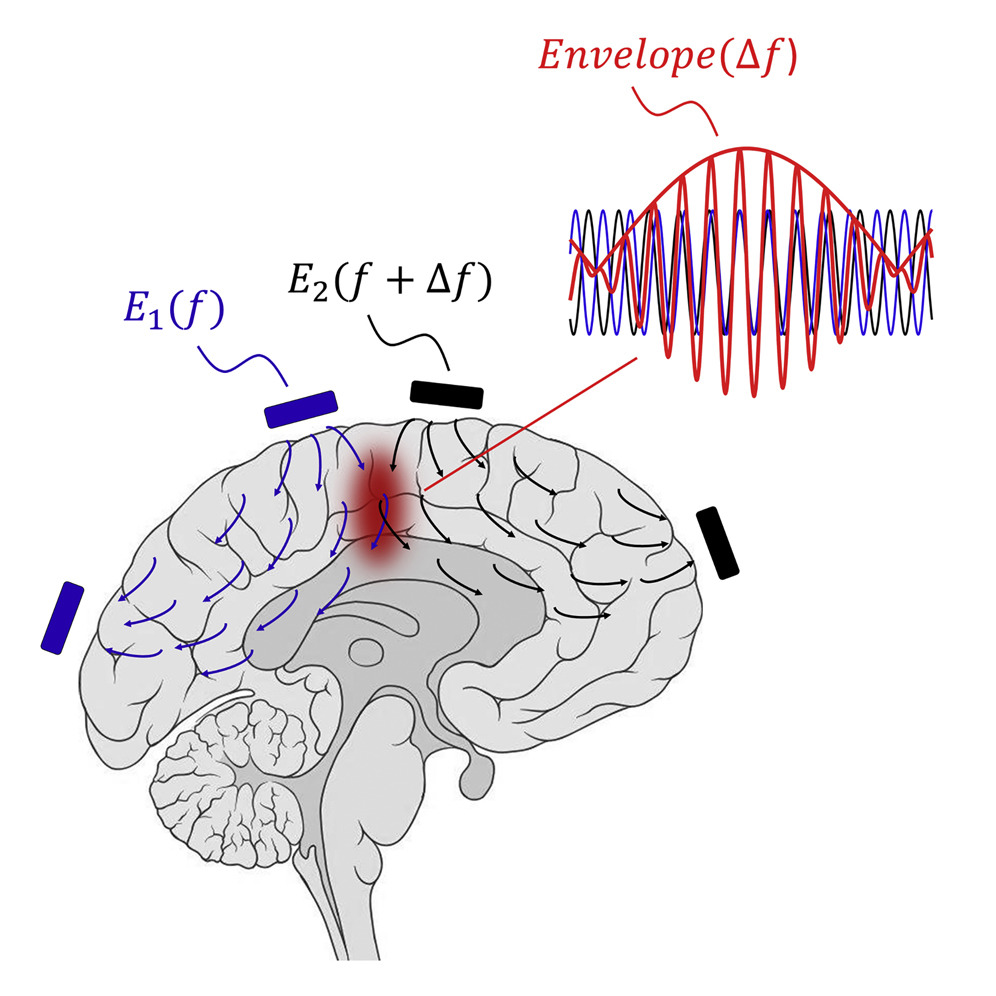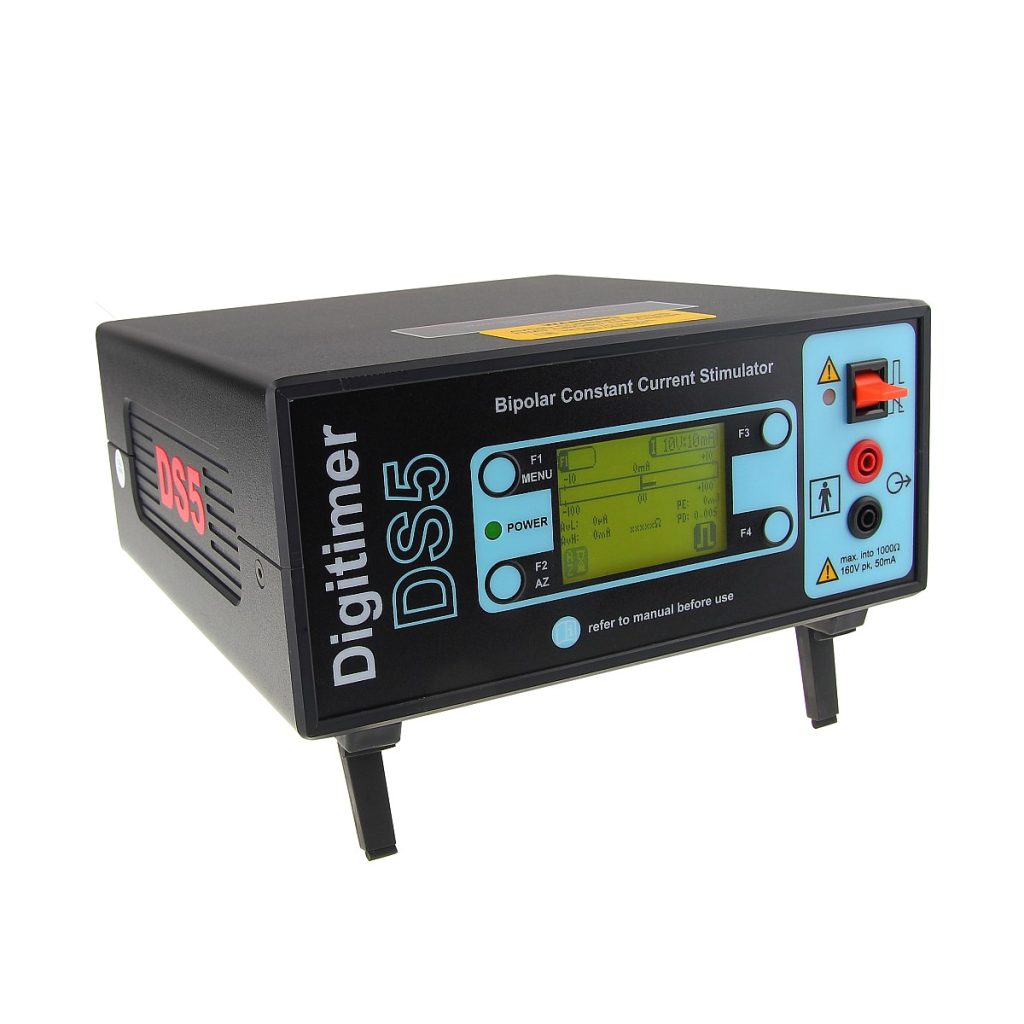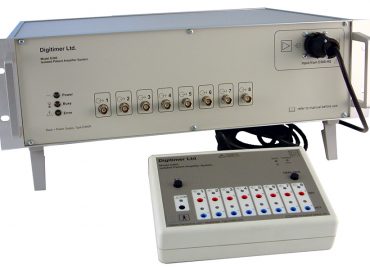Temporal Interference Stimulation – A New Application for Pairs of DS5 Stimulators
Introduction
Temporal Interference (TI) Stimulation is a relatively new stimulation method that shows potential as a technique to electrically activate specific brain regions or peripheral nerves without the need for implanted electrodes (Grossman et al., 2017). Cutting-edge research is attempting to understand how TI stimulation might be safely utilized and optimized to replace invasive deep brain stimulation methods that are currently used to treat conditions including epilepsy, tremor and Parkinson’s disease or to better target peripheral nerve activation for a variety of applications, including arthritis and chronic inflammation.
TI stimulation relies on the delivery of high-frequency (typically >1kHz) electrical stimulation from two current sources. Ordinarily, stimulation at such high frequencies does not result in the recruitment of neuronal firing, however, if the two stimulation sources produce waveforms with frequencies that differ by a small amount, they will generate an interference envelope that “beats” at a lower frequency. This will activate underlying neurons in the location where the two stimulus waveforms intersect.
TI stimulation is an experimental technique and researchers within this field are specifically interested in learning how the method might be harnessed for future clinical applications. This research involves experimenting with the types of waveforms used as well as different electrode types and configurations.
Much of the research is currently conducted in animals or human cadavers, but if this research is to be conducted in vivo in humans, it is necessary to identify current sources that are safe and able to generate the high-frequency waveforms required for TI stimulation.

Using Pairs of Digitimer DS5’s for TI Stimulation
The Digitimer DS5 Bipolar Constant Current Stimulator was originally developed for transcutaneous peripheral nerve stimulation, specifically in threshold-tracking studies of human axonal excitability. The DS5 is a medical device, CE certified to the European Medical Device Directive (MDD)* and unlike more conventional triggered pulse stimulators, like our DS7A or DS8R, the DS5 is controlled by an analogue voltage waveform. The DS5 stimulator uses this command waveform as a template to generate a proportional isolated current output. This means that the DS5 may be used to stimulate with complex waveforms such as sine waves or arbitrary shapes. As a result, a pair of DS5 stimulators combined with a two-channel signal generator can create a versatile TI stimulation system, suitable for human research applications.
Hardware configuration couldn’t be simpler – just set the input voltage and output current ranges on the DS5’s to match the signal source and the current output required, then configure the preferred two channel signal source and/or software to generate waveforms of the desired frequencies. The DS5 features standard 4mm touch-proof sockets for electrode connection, but Digitimer can also supply an electrode connection cable that converts from these 4mm connectors to the more common 1.5mm DIN42802 type.
* The intended use of the Digitimer DS5 is as a peripheral nerve stimulator, used singly on a human subject. Simultaneous use of more than one stimulator or transcranial use is not covered by existing medical device certification.
Want to learn more?
If you would like to learn more about how the DS5 can be used as part of a temporal interference stimulation system, please take a look at the publications below, which have all used DS5’s, or get in touch with Digitimer.
Jabban, L., Ribeiro, M., Andreis, F.R., dos Santos Nielsen, T.G.N. and Metcalfe, B.W., 2022, July. Pig Ulnar Nerve Recording with Sinusoidal and Temporal Interference Stimulation. In 2022 44th Annual International Conference of the IEEE Engineering in Medicine & Biology Society (EMBC) (pp. 5084-5088). IEEE. https://ieeexplore.ieee.org/abstract/document/9871603
Missey, F., Ejneby, M.S., Ngom, I., Donahue, M.J., Trajlinek, J., Acerbo, E., Botzanowski, B., Cassara, A., Neufeld, E., Glowacki, E.D. and Shangold, L., 2023. Obstructive Sleep Apnea Improves with Non-invasive Hypoglossal Nerve Stimulation using Temporal Interference. bioRxiv, pp.2023-04. https://www.biorxiv.org/content/10.1101/2023.04.06.535917v1.abstract
Acerbo, E., Jegou, A., Luff, C., Dzialecka, P., Botzanowski, B., Missey, F., Ngom, I., Lagarde, S., Bartolomei, F., Cassara, A.M. and Neufeld, E., 2022. Focal non-invasive deep-brain stimulation with temporal interference for the suppression of epileptic biomarkers. Frontiers in Neuroscience, p.1260. https://www.frontiersin.org/articles/10.3389/fnins.2022.945221/pdf
Violante, I.R., Alania, K., Cassarà, A.M., Neufeld, E., Acerbo, E., Carron, R., Williamson, A., Kurtin, D.L., Rhodes, E., Hampshire, A. and Kuster, N., 2022. Non-invasive temporal interference electrical stimulation of the human hippocampus. bioRxiv, pp.2022-09. https://www.biorxiv.org/content/10.1101/2022.09.14.507625v2.abstract
Botzanowski, B., Donahue, M.J., Ejneby, M.S., Gallina, A.L., Ngom, I., Missey, F., Acerbo, E., Byun, D., Carron, R., Cassarà, A.M. and Neufeld, E., 2022. Noninvasive Stimulation of Peripheral Nerves using Temporally‐Interfering Electrical Fields. Advanced Healthcare Materials, 11(17), p.2200075. https://onlinelibrary.wiley.com/doi/full/10.1002/adhm.202200075
Wessel, M.J., Beanato, E., Popa, T., Windel, F., Vassiliadis, P., Menoud, P., Beliaeva, V., Violante, I.R., Abderrahmane, H., Dzialecka, P. and Park, C.H., 2022. LTP-like noninvasive striatal brain stimulation enhances striatal activity and motor skill learning in humans. bioRxiv, pp.2022-10. https://www.biorxiv.org/content/10.1101/2022.10.28.514204v1.abstract
Vassiliadis, P., Beanato, E., Popa, T., Windel, F., Morishita, T., Neufeld, E., Duque, J., Derosiere, G., Wessel, M.J. and Hummel, F.C., 2022. Non-invasive stimulation of the human striatum disrupts reinforcement learning of motor skills. BioRxiv, pp.2022-11. https://www.biorxiv.org/content/10.1101/2022.11.07.515477v2.abstract



